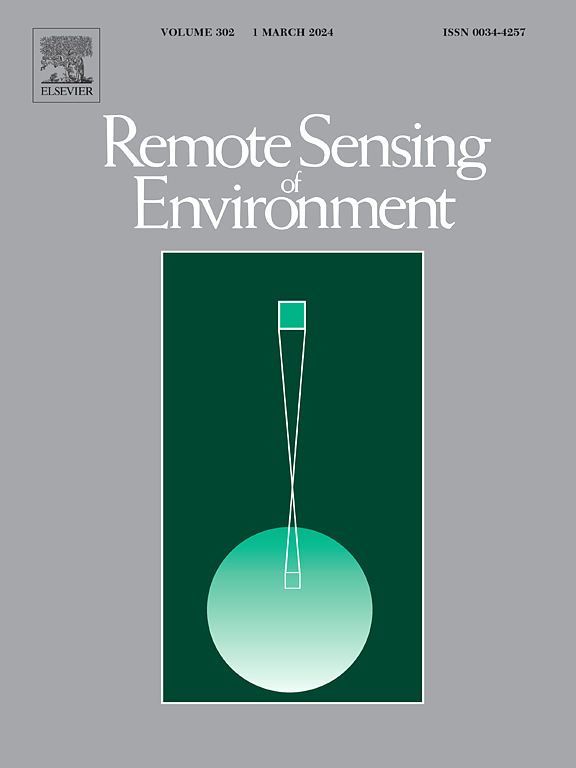A long-term global Mollisols SOC content prediction framework: Integrating prior knowledge, geographical partitioning, and deep learning models with spatio-temporal validation
IF 11.1
1区 地球科学
Q1 ENVIRONMENTAL SCIENCES
引用次数: 0
Abstract
Recently, Soil Organic Carbon (SOC) content has declined across global Mollisols region due to erosion, intensive agriculture, and other factors, weakening the soil's capacity to buffer climate change and necessitating urgent monitoring of SOC dynamics. Large-scale SOC content monitoring using remote sensing technology faces challenges in extracting advanced features from remote sensing data and mitigating the negative impact of high spatial heterogeneity in SOC content on prediction accuracy. To address these challenges, we collected 8984 samples, 956,423 Landsat TM/OLI images, shuttle radar topography mission-digital elevation model data, and meteorological data. We developed a Geographic Knowledge Dataset (GEKD) incorporating prior knowledge of soil formation and erosion processes. We then input the GEKD into a Probability Hybrid Model (PHM). In the PHM, we applied a fuzzy Gaussian mixture model to cluster the global Mollisols region and calculate corresponding probabilities. We then built a high-accuracy SOC content prediction model by integrating the Attention mechanism, Convolutional Neural Networks, and Convolutional Long Short-Term Memory Networks (A-CNN-ConvLSTM). Finally, we generated spatial maps of SOC content at a 30 m resolution for 8 periods since 1984 and verified the accuracy of its spatial distribution and temporal variation patterns. The results showed that (1) the highest SOC content prediction accuracy (RMSE = 7.17 g/kg, R2 = 0.72, and RPIQ = 1.92) was achieved when GEKD was input into PHM using the A-CNN-ConvLSTM algorithm. (2) PHM effectively reduces the negative impact of high SOC spatial heterogeneity on prediction accuracy, resulting in smoother spatial distribution at cluster boundaries. Compared to the global model, PHM reduced RMSE by 1.66 g/kg and improved R2 and RPIQ by 0.06 and 0.15, respectively. (3) Compared to the commonly used random forest algorithm, A-CNN-ConvLSTM reduced RMSE by 1.50 g/kg and improved R2 and RPIQ by 0.13 and 0.47, respectively. The spatial context features extracted by the CNN structure in the A-CNN-ConvLSTM algorithm are the most effective in improving SOC content prediction accuracy. (4) Currently, the SOC content across continents in the global Mollisols region is ranked as follows: Siberia (27.21 g/kg) > Europe (26.78 g/kg) > Asia (20.48 g/kg) > North America (20.43 g/kg) > South America (16.49 g/kg). Since 1984, SOC content has shown a decreasing trend, with the global Mollisols region losing 1.91 g/kg overall. The Asian Mollisols region experienced the largest decline (2.93 g/kg), while Siberia saw the smallest decrease (1.45 g/kg).
长期全球Mollisols有机碳含量预测框架:整合先验知识、地理分区和深度学习模型与时空验证
近年来,受侵蚀、集约化农业等因素影响,全球Mollisols地区土壤有机碳(SOC)含量下降,土壤缓冲气候变化的能力减弱,迫切需要对土壤有机碳动态进行监测。大规模土壤有机碳遥感监测面临着从遥感数据中提取先进特征和减轻土壤有机碳含量空间异质性对预测精度的负面影响的挑战。为了应对这些挑战,我们收集了8984个样本,956,423张Landsat TM/OLI图像,航天飞机雷达地形任务数字高程模型数据和气象数据。我们开发了一个包含土壤形成和侵蚀过程先验知识的地理知识数据集(GEKD)。然后我们将GEKD输入到概率混合模型(PHM)中。在PHM中,我们采用模糊高斯混合模型对全局Mollisols区域进行聚类,并计算相应的概率。然后,我们通过集成注意机制、卷积神经网络和卷积长短期记忆网络(a - cnn - convlstm)建立了高精度的SOC含量预测模型。最后,我们制作了1984年以来8个时段30 m分辨率的有机碳含量空间图谱,验证了其空间分布和时间变化格局的准确性。结果表明(1)使用A-CNN-ConvLSTM算法将GEKD输入到PHM时,SOC含量预测精度最高,RMSE = 7.17 g/kg, R2 = 0.72, RPIQ = 1.92。(2) PHM有效降低了高碳水化合物空间异质性对预测精度的负面影响,使聚类边界的空间分布更加平滑。与全球模型相比,PHM将RMSE降低1.66 g/kg,将R2和RPIQ分别提高0.06和0.15。(3)与常用的随机森林算法相比,A-CNN-ConvLSTM的RMSE降低了1.50 g/kg, R2和RPIQ分别提高了0.13和0.47。在A-CNN-ConvLSTM算法中,由CNN结构提取的空间上下文特征对提高SOC含量预测精度最为有效。(4)目前,全球Mollisols地区各大洲有机碳含量排序如下:西伯利亚(27.21 g/kg) >;欧洲(26.78 g/kg) >;亚洲(20.48 g/kg);北美(20.43 g/kg) >;南美洲(16.49 g/kg)。1984年以来,土壤有机碳含量呈下降趋势,Mollisols地区整体减少1.91 g/kg。亚洲Mollisols地区下降幅度最大(2.93 g/kg),而西伯利亚地区下降幅度最小(1.45 g/kg)。
本文章由计算机程序翻译,如有差异,请以英文原文为准。
求助全文
约1分钟内获得全文
求助全文
来源期刊

Remote Sensing of Environment
环境科学-成像科学与照相技术
CiteScore
25.10
自引率
8.90%
发文量
455
审稿时长
53 days
期刊介绍:
Remote Sensing of Environment (RSE) serves the Earth observation community by disseminating results on the theory, science, applications, and technology that contribute to advancing the field of remote sensing. With a thoroughly interdisciplinary approach, RSE encompasses terrestrial, oceanic, and atmospheric sensing.
The journal emphasizes biophysical and quantitative approaches to remote sensing at local to global scales, covering a diverse range of applications and techniques.
RSE serves as a vital platform for the exchange of knowledge and advancements in the dynamic field of remote sensing.
 求助内容:
求助内容: 应助结果提醒方式:
应助结果提醒方式:


